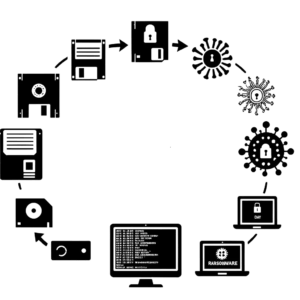
Malware, short for malicious software, has come a long way since the early days of simple computer viruses. The landscape of cybersecurity threats has evolved significantly, with cybercriminals constantly innovating and developing more sophisticated forms of malware.
From the early viruses that spread through infected removable media to the advanced ransomware attacks that encrypt entire systems and demand payment for decryption keys, the types of malware in circulation have grown in complexity and impact.
Today, different forms of malware exist to target various vulnerabilities and exploit them in different ways. Some common types of malware include worms, trojans, adware, spyware, and ransomware. Each type has its own method of infiltration and malicious intent, making them a persistent threat to individuals, businesses, and organizations alike. Ransomware, in particular, has gained notoriety for its ability to cause widespread disruption and financial loss.
As cybersecurity measures continue to advance, cybercriminals adapt and find new ways to circumvent detection and infiltrate systems. Understanding the different types of malware and how they operate is crucial for staying ahead of cyber threats and protecting sensitive information.
Understanding Viruses
What are computer viruses? How do they work?
Computer viruses are harmful programs created to infect and spread to many devices. They often hide in innocent-looking files or programs and can harm your computer in different ways. When a virus gets into a device, it can make copies of itself and move to other files, programs, or devices on the same network.
Computer viruses are like sneaky hitchhikers that attach themselves to normal files or programs. When you open or run the infected file, the virus can do all sorts of bad things like messing up your data, stealing your important information, or even breaking your device. Some viruses are sneaky and hide until something specific happens to activate them, which can make them really tricky to find and get rid of.![]()
To keep your computer safe from viruses, you should use antivirus software, regularly update your system, and be careful when browsing online to avoid downloading harmful files or visiting dangerous websites.
Real-life Examples and Impact of Computer Viruses
For many years, computer viruses have been causing major problems for people and companies. As technology evolves, these viruses are getting even more dangerous. For example, in 2017, the WannaCry virus infected hundreds of thousands of computers all over the world, causing lots of issues for different businesses. Another virus, called Stuxnet, was even used to attack important industrial systems, like Iran’s nuclear program. These examples show how serious the threat of cyber attacks can be.
Computer viruses can lead to devastating consequences such as financial loss, data theft, and even national security threats. For instance, the NotPetya ransomware attack in 2017 cost global companies billions of dollars in damages, underscoring the importance of robust cybersecurity measures. Additionally, the Mirai botnet malware exploited IoT devices to launch massive DDoS attacks, highlighting the interconnectedness of cybersecurity risks in the digital age.
These real-life examples emphasize the critical need for individuals and organizations to stay vigilant against evolving malware threats, highlighting the importance of cybersecurity awareness and proactive defense strategies.
Exploring Types of Malware, Trojans and Worms
Definition, functionality and effects of a Trojan
When talking about harmful computer viruses, Trojans are often seen as one of the sneakiest and most harmful types of malware. Trojans pretend to be harmless files or programs to fool users into downloading them, but once they’re on your computer, they do all sorts of bad things without you knowing. This can include stealing important information like your passwords or money, or letting hackers get into your computer without your permission.
The effects of a Trojan infection can be devastating, leading to financial losses, privacy breaches, and even complete system compromise. Trojans have the ability to operate stealthily in the background, evading detection by antivirus programs and security measures. Their stealthy nature makes them a formidable threat in the cybersecurity realm, as they can quietly wreak havoc on unsuspecting users and organizations.
Understanding Worms and Their Implications
In the world of online threats, worms are a dangerous type of malware that can quickly spread through networks and devices. Unlike viruses, worms don’t need a specific file to infect and reproduce, so they can move fast and on their own. This makes worms very risky because they can get into systems, steal important information, and even cause major disruptions to networks.
One important thing to know about worms is that they can spread on their own without any help from users. This can make them really hard to control and get rid of once they get into a computer system. They can also take advantage of weaknesses in software to sneak into networks without permission, posing a big risk to online security. To protect against worms, companies need to make sure they have strong security measures in place, like keeping their software up to date and separating different parts of their networks to limit the damage that worms can do.
Understanding the behavior and implications of worms is crucial for cybersecurity professionals to effectively defend against these threats and safeguard sensitive data. By staying informed about the latest worm variants and adopting proactive cybersecurity practices, organizations can enhance their resilience against evolving malware threats.
Ransomware Attacks
Function and Impact of Ransomware
Ransomware is a harmful kind of software that blocks you from using your computer or accessing your data until you pay a certain amount of money. It does this by making your files unreadable or preventing you from using your device until you give in and pay the ransom. This can have a really bad impact on regular people, companies, and groups. It can cause you to lose important information, lose money, harm your reputation, or even mess up your ability to work.
One of the most concerning aspects of ransomware is its evolution and sophistication. As cybercriminals continue to refine their tactics, ransomware attacks have become more targeted and destructive. From spreading through phishing emails to exploiting vulnerabilities in systems, ransomware poses a significant threat to cybersecurity. The financial incentives driving ransomware attacks have made them a lucrative business for cybercriminals, leading to an increase in the frequency and severity of such incidents.
Protecting against ransomware involves using different methods, such as strong online security measures, regularly creating backups of important data, educating employees about phishing, and ensuring that computer systems and software are always updated. By knowing how ransomware works and the harm it can cause, people and businesses can be more prepared and able to protect themselves from this dangerous threat.
The future of malware
Recent malware trends and cyber security measures
In our modern world of technology, the danger of malware is always changing and growing quickly. There are many different types of malware, like viruses and ransomware, that can put people and organizations at risk. One new trend we’ve seen is fileless malware, which can hide in a computer’s memory and not leave any evidence on the hard drive, making it tough to find with regular antivirus programs. Another concerning development is ransomware attacks, where hackers are targeting important systems and asking for large amounts of money to unlock them.
In order to protect against new and changing online threats, it is very important for people and companies to use strong cyber security measures. This means keeping your computer updated with the latest security fixes, checking for weaknesses regularly, and using advanced protection programs for your devices. It is also important to learn about online safety and pay attention to potential risks in order to avoid getting harmful viruses on your devices. By staying informed and keeping good online habits, individuals can better defend themselves against threats.
Preventive Measures and Responses to Malware Attacks
To protect against malware attacks, it’s important to be proactive by taking preventive measures. This means using strong antivirus software, keeping your operating systems and software up-to-date, and educating your employees on how to stay safe online. Regularly checking for security weaknesses and testing your systems can also help prevent malware from causing damage.
In the case of a malware attack, it’s important to have a plan in place. This involves isolating infected computers to stop the spread, figuring out what kind of virus it is and how it got in, and then getting rid of it using antivirus programs or cybersecurity help. You should also check how much harm has been done, restore any affected computers from clean backups, and make your system more secure to avoid more attacks in the future.
By learning about different types of malicious software, like viruses and ransomware, and being proactive with security measures and response plans, companies can improve their defenses against the changing world of cyber attacks.
